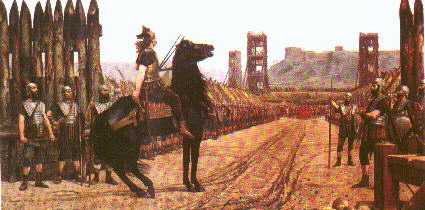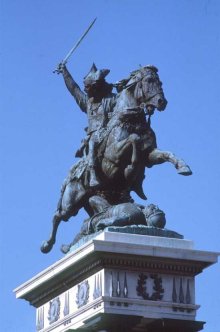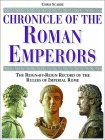Later that year, Vercingetorix and his men were trapped in the stronghold of Alesia, near present-day Dijon. Caesar surrounded the oppidum and began to construct siege works. The defenders had food only for a month, and Caesar hoped to starve them into surrender before reinforcements could arrive.
The circumvallation extended around the town for ten miles, too large to be occupied by the Romans. It therefore was made more secure by a series of defenses. First, facing the town, a trench twenty-feet wide was dug to protect against surprise attack. Six hundred and fifty yards behind this ditch two more trenches were dug, each fifteen feet wide and the inner one filled with water. Behind these trenches was a palisaded rampart twelve feet high, with a breastwork of earth studded with forked branches. Around the entire circuit of the wall, towers were erected every one hundred and thirty yards.
 Still, there were attacks by the Gauls, and the siege works were strengthened even more. Tree trunks and strong branches were cut and sharpened, and buried securely in rows in front of the trenches. In front of them, diagonal rows of pits also were dug, each three-feet deep with a thick sharpened stake at the bottom and covered with brush to hide the trap. And, in front of these, blocks of wood were buried in the ground with iron barbs (stimuli) fixed in them.
Still, there were attacks by the Gauls, and the siege works were strengthened even more. Tree trunks and strong branches were cut and sharpened, and buried securely in rows in front of the trenches. In front of them, diagonal rows of pits also were dug, each three-feet deep with a thick sharpened stake at the bottom and covered with brush to hide the trap. And, in front of these, blocks of wood were buried in the ground with iron barbs (stimuli) fixed in them.
Aware that Vercingetorix had sent for reinforcements to break the siege, Caesar had an similar line of defense constructed facing outward to protect against attack from a relief force.
Before it arrived, a tragic thing happened. By now, the food in the town had been exhausted, and it was determined that all those who could not fight were to be turned out. The inhabitants of Alesia, who had given refuge to Vercingetorix and his men, now were compelled to leave the town, together with their wives and children. Starving, they beseeched the Romans on the surrounding walls to take them in as slaves. But the population was refused any refuge and left to die of hunger between the two armies.

|









 Actual footage from ancient Rome
Actual footage from ancient Rome 
